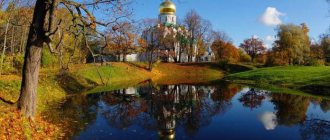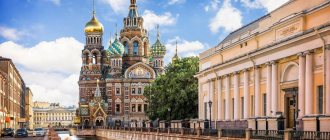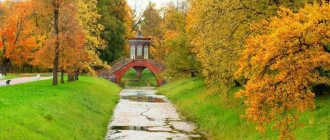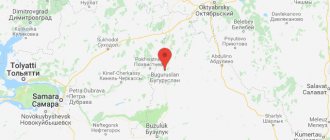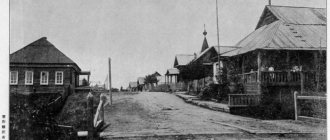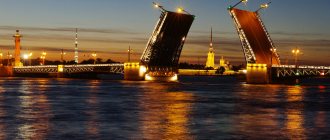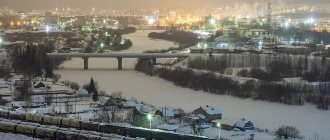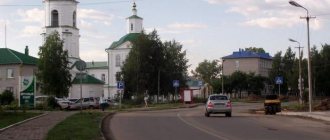> Countries Russia St. Petersburg
Pushkin is one of the most picturesque suburbs of St. Petersburg. Historical and architectural monuments of the 18th century and residential buildings of the 19th century are well preserved here. It includes the famous Tsarskoe Selo museum-reserve with picturesque parks, luxurious palaces and unusual pavilions. This is a great travel destination where you can see the center in one day, as well as admire nature or immerse yourself in the rich history of these places.
- In the center
- Neighborhood
- Excursions
- Map
The significance of the city of Pushkin in the modern world
The city of Pushkin is part of the district of the federal city of the same name called St. Petersburg and its intracity municipal formation.
Over the years, the settlement was called:
| Before 1710 | Sarskaya Manor |
| Before 1724 | Blagoveshchenskoe |
| Before 1780 | Sarskoe village |
| Before 1917 | Tsarskoye Selo |
| Before 1918 | Soldiers' Village |
| Before 1937 | Children's village named after Uritsky |
Currently, a public movement has been founded in the city, which advocates the return of the historical name “Tsarskoye Selo”.
The city is the largest tourist, scientific, educational and military-industrial center. The date of its foundation is 1710. The settlement received city status in 1808. Its total occupied area is 89,241 square meters. km.
Initially, the city was positioned as a country imperial residence. Subsequently, a museum was organized here. The iconic monument of urban planning art and the palace park complex (founded in the 18th-20th centuries) is called “Tsarskoe Selo”. It included the world famous Catherine Park, Catherine Palace and numerous other religious buildings.
The modern layout of the city was determined at the beginning of the 20th century. Pushkin has a clear layout and consists of 2 main parts: northeastern and southern.
The northeastern part of the settlement arose on the site of the Old Sloboda and has the main Cathedral Square on its territory. Almost all the streets of the district intersect at an angle of 90°; the oldest streets are called Sadovaya, Srednyaya and Malaya.
The southern part of the city is located on the site of the former city called Sofia and its center is Sofia Square.
The modern administrative division of the city into districts:
- Historical Center;
- Sofia;
- Krasnoselka;
- Friedenthal Colony;
- BAM;
- New village;
- Belozerka;
- Novoselki;
- Pavlovsk;
- Lesnoye;
- Kondakopshino;
- Novokondakopshino;
- Volkhonka.
Feodorovsky Sovereign Cathedral
Address: Academic Avenue, 34 Telephone: (office), +7(812)466-61-69 (on duty) Website : https://gosudarevsobor.cerkov.ru Opening hours: 09:00 (Saturday and Sunday. from 7.30) –18:50. On Christmas, Easter, on the Day of Remembrance of the Royal Martyrs (July 17) and some holidays - around the clock. Cost: free entry
Feodorovsky Cathedral is located in the lower part of Alexander Park, where the Farmer Park begins. It was built for officers of the Imperial Consolidated Regiment and Convoy. It is believed that the place for the temple was chosen by Nicholas II himself, who laid the first foundation stone.
Architect V.A. By order of the emperor, Pokrovsky created a one-domed cathedral, somewhat reminiscent of the Moscow Annunciation Cathedral. The temple has not only an upper, but also a lower church, where services were held for the royal family in the winter. At the beginning of the 20th century, ordinary people were allowed to enter the temple only during Orthodox holidays, and then only by special invitation.
Nicholas II planted oak trees near the Feodorovsky Cathedral in honor of the birth of his children. A monument to the emperor was subsequently erected at this site.
The temple was opened to visitors only after the revolution, but during the Stalin era it was converted into a cinema, leaving the dome and external decoration. The building was seriously damaged during the war and was restored only in 1995. The cathedral is known among believers for its revered copy of the Feodorovskaya Icon of the Mother of God.
Climate
The city of Pushkin is located in a humid and temperate climate zone, which is gradually transforming from marine to continental.
Over the years of meteorological observations, the following climatic conditions have been recorded in the city:
| Month | Day °C | Night °C | Comfort rating out of 5 |
| January | -5,3 | -9,4 | 2,5 |
| February | -3,6 | -8,3 | 2,5 |
| March | +0,2 | -5,2 | 4,2 |
| April | +7,8 | +0,5 | 4,2 |
| May | +16,3 | +6,5 | 4,6 |
| June | +19,1 | +9,7 | 4,8 |
| July | +23,2 | +13,4 | 5,0 |
| August | +21,0 | +12,3 | 5,0 |
| September | +15,4 | +8,5 | 4,5 |
| October | +7,1 | +2,8 | 4,2 |
| November | +2,3 | -0,6 | 4,2 |
| December | -2,1 | -5,3 | 2,5 |
According to the comfort rating, July and August are considered the most successful months for traveling to the city of Pushkino.
Average climate data in Pushkino:
| Month | Sunny days | Precipitation in mm | Wind speed in m/s | Rainy days |
| January | 2 | 20,23 | 3,3 | 2 |
| February | 0 | 24,45 | 3,3 | 4 |
| March | 4 | 16,37 | 3,3 | 7 |
| April | 8 | 25,45 | 3,2 | 12 |
| May | 19 | 15,66 | 3,0 | 9 |
| June | 16 | 26,09 | 3,1 | 12 |
| July | 16 | 30,58 | 2,8 | 13 |
| August | 19 | 35,78 | 2,9 | 13 |
| September | 12 | 19,76 | 3,1 | 11 |
| October | 5 | 20,88 | 3,5 | 10 |
| November | 2 | 21,39 | 3,6 | 9 |
| December | 1 | 23,83 | 3,8 | 6 |
Businesses and work in the area
From an economic point of view, it is also hardly possible to bring the municipalities of the Pushkin region to some common denominator. Somewhere there are more tourist sites, somewhere there are more industrial ones.
Statistics show that in the district there are about 800 different enterprises, large and small, that regularly pay taxes to the city treasury. Among those that have not yet been named are an enterprise engaged in the production of woodworking equipment (production of railway equipment and mechanical engineering), furniture and food industries, for example, such giants as “Daria” (semi-finished meat products), “Russian Standard” (strong alcoholic drinks) or Tinkoff (brewery) are also located in the Pushkinsky district.
Flora and fauna
The variety of ground cover occurs due to the presence of hills, ridges, terraces, flat areas, forests and farmland. Lakes, ponds and rivers in the city and its surroundings are replenished exclusively with spring water.
It has been established that in ancient times the ground under the modern city was covered with sediments, which formed a 200-meter crystalline foundation consisting of:
- sand;
- sandstone;
- limestone;
- clay;
- granite;
- gneiss;
- Diabase.
The modern terrain was formed by the activity of the ice sheet, the last recorded Valdai glaciation of which occurred about 12 thousand years ago. After his retreat, the Littorina Sea was formed, the level of which at that time was approximately 8 m higher than the modern one.
The retreat of the sea and the formation of the Neva River valley occurred about 4 thousand years ago. Currently, the valley is composed of lacustrine glacial and post-glacial deposits, which have not changed their structure for the last 2.5 thousand years.
Due to its location and structure, the Pushkinsky district has a predominance of vegetation:
- gray alder;
- downy birch;
- warty birch;
- black alder.
In the suburbs there are broad-leaved forests in which grow:
- Norway maple;
- small-leaved linden;
- English oak;
- rough elm;
- smooth elm;
- common ash;
- common hazel.
Here you can find a large number of berries and medicinal herbs:
- bearberry;
- May lilies of the valley;
- blueberries;
- lingonberries;
- raspberries;
- cranberries;
- juniper;
- wild rosemary;
- Potentilla erecta.
The fauna is represented by 68 species of mammals, the most common animals are:
- martens and squirrels;
- moles and hares;
- hedgehogs and rodents;
- wolves and wild boars;
- roe deer and foxes;
- moose and bears;
- weasels and otters;
- beavers and minks.
The region is home to almost 300 species of birds, some of which are migratory. There are about 80 species of fish in the region's reservoirs. Some forest inhabitants are included in the Red Data Book and are strictly protected by law.
Population of the area
Of the 136 thousand people living in the Pushkinsky district in 2010, more than 60% are the adult working population. There is a constant influx of “new blood” into the area: economical housing is bought by those who want to live within the city limits and not overpay for proximity to the metro or the center. There are many visitors here - both from other regions of Russia and from the former republics of the Soviet Union.
The birth rate in the Pushkinsky district exceeds the death rate: there are many children and, as a result, various children's infrastructure: children's playgrounds, entertainment complexes and preschool institutions.
Playground
The vast majority of residents of the area work in St. Petersburg, which is what causes the enormous burden on local public transport. Due to the fact that the Pushkinsky district is a tourist center, some of the population works in this segment of the market, providing excursion, administrative and technical services to local attractions.
On the territory of the district there are also military units, several institutions of higher and secondary vocational education, which also influences how the social image of the region is formed. In general, the overwhelming majority of residents of the Pushkinsky district are people with higher education, young, with an active lifestyle, who want development both for themselves and for the place they have chosen to live.
How to get there
The city of Pushkin is part of the administrative subordination of Leningrad. There are many ways to get there and enjoy local attractions.
By plane
The fastest way to get to the city is by plane.
The airports closest to the city are:
| Name | Distance (in km) |
| Chkalovsky | 20,61 |
| Sheremetyevo | 36,44 |
| Vnukovo | 69,59 |
| Domodedovo | 77,62 |
By train
Traveling to Pushkin by train can be economically beneficial, but at the same time longer in time. The railway station is located at the address Pushkin, Privokzalnaya Square, building No. 1.
Railway station of the city of Pushkin
The city is considered an important transport center of the region; the St. Petersburg – Vitebsk railway line runs through it. On the territory of the city there is a station called Tsarskoe Selo and a stop point Detskoselsky.
By bus
From nearby cities you can get to Pushkino by intercity bus. The bus station is located at: st. Zheleznodorozhnaya, building No. 40 “a”.
The bus station is open to visitors from 05.10 to 01.00.
By car
From almost any city in Russia you can get to Pushkino by car. The distance from Moscow will be about 700 km.
The road will pass through the following settlements:
- Khimki;
- Wedge;
- Tver;
- Bologoe;
- Miraculous;
- Sokolov Stream;
- New.
District infrastructure
Much of the infrastructure of the Pushkinsky district was described above in the story about municipalities. Too different settlements are part of this administrative division of the Northern capital to be able to make any generalizations.
Among the events of regional significance, one can, of course, highlight the joint Russian-Finnish project to reconstruct and update local treatment facilities, built here back in 1975. The project was implemented over several years and was completely completed by 2005.
In the entire Pushkinsky district there are about 20 secondary schools, several dozen kindergartens and medical institutions. There are more than 10 libraries in the area, of which the Central Children's Library and the D. Mamin-Sibiryak Library can be highlighted. There are many sports schools and children's and youth creative associations here. Chamber music concerts known throughout Europe and the annual Tsarskoye Selo Carnival are regularly held.
Tsarskoye Selo Carnival
Among the higher educational institutions located in the Pushkinsky district, one can highlight the Leningrad Regional State University named after. Pushkin, St. Petersburg State Agrarian University, Military Space Academy named after. Mozhaisky, Institute of Law and Entrepreneurship and many others.
Main attractions
The city of Pushkin is part of the “Historical Center of St. Petersburg and the associated complex of monuments” object.
Religious buildings
The Znamenskaya Church is the oldest building in the city. It was built by order of Empress Elizabeth Petrovna. In it she prayed in solitude and hid from prying eyes.
The Egyptian Gate in the vicinity of the city was erected in the 30s of the 19th century. The structure consists of 2 pylon towers, decorated in the ancient Egyptian style.
Inside, the towers are divided into 3 floors, on the facades of which there are images of deities:
- Maata;
- Osiris;
- Isis;
- Mountain.
The Cameron Gallery was built at the end of the 18th century under the direction of the architect Charles Cameron. The building is striking in its elegance, and its surroundings are one of the favorite walking places for city residents and visitors.
The White Tower is the tallest building in Tsarskoe Selo. The 38-meter structure originally served as an observation deck. It has several tiers and is decorated with a parapet and figurines.
Museums
There are a large number of religious attractions in Pushkino, in which museums are currently open. The Catherine Palace is the main attraction of the city. It is located at: st. Sadovaya, house No. 7. The museum in a historical building is open to visitors from 10 a.m. to 5 p.m.
Cost of visit:
- full ticket price 700 rubles;
- for pensioners, students over 16 years of age and citizens of Belarus – 350 rubles;
- for children under 16 years of age – free.
The Alexander Palace was built by order of Catherine II at the very end of the 18th century. The building is closely connected with the life of the last Russian emperor, who lived in it from 1905 until his exile to Siberia. Currently, the personal belongings of the emperor and his family are exhibited in an organized historical museum.
The Tsarskoye Selo Lyceum is one of the branches of the A. S. Pushkin Museum. The Lyceum displays exhibits related to the great Russian poet. You can walk through the lyceum on your own or as part of a tourist group.
Natural attractions
Buffer Park has the status of the youngest park in the city, its foundation date was 1980. It is a flat valley on which 5 lakes are located. Before the opening of the park, the ancient imperial railway passed here, and currently the main city holidays are held. On weekdays, this is a favorite walking place for city residents.
The colony pond is of artificial origin. It was created by human hands almost 2 centuries ago and is a picturesque vacation spot, overgrown with willows and tall grass. There is a beach on the shore of the pond where Epiphany bathing takes place in the winter.
Near the Catherine Palace there is a picturesque Catherine Park, consisting of the Old Garden and the English Park. The foundation of the park dates back to the reign of Peter I. Empress Catherine II was involved in the completion and expansion of the park.
Historical monuments
Pushkino has a huge number of historical monuments that are of particular value on a global scale.
The Amber Room is the main relic of the Catherine Palace. An exact copy of a room that disappeared during the Second World War is an outstanding feat of Russian restorers, who spent 23 years recreating a unique creation from Kaliningrad amber from surviving photographs.
The Great Hall of the Catherine Palace or the Light Gallery has an area of 840 square meters. m (length 47 m with width 17 m). The hall consists of 2 tiers of windows located on both sides of the hall and a huge number of mirrors between them. Thanks to the unique architecture, the room amazes with its beauty and seems very bright.
The golden or ceremonial suite of the Catherine Palace is a cascade of halls following each other, with a total length of almost 300 m. The doorways, located one after the other, are richly decorated with gilded carvings. Due to its location, the passage seems endless.
Alexandrovsky Park
Address: st. Dvortsovaya, 2 Telephone: Website: https://www.tzar.ru/museums/palaces/alexander_park Opening hours: 07.00-21.00 Cost: free admission
Alexander Park deservedly bears the name of Emperor Alexander I: the Tsar made it for himself, since he loved to walk there just like his grandmother Catherine the Great. The park occupies 200 hectares, and tourists usually get there through the Chinese Bridge, which is located at the entrance to the Catherine Palace. There is another entrance - the gate at the Alexander Palace.
The park consists of two parts: the Regular Park with regular alleys, flower beds, and well-groomed trees, and the English Park, which resembles a forest rather than a park.
While walking through the Regular Park, it is worth looking at:
- Bulk mountain "Parnassus"
- Curtain (earthen rampart) “Mushroom”
- Five Chinese style bridges
- Chinese village and theater
The attractions of the English (landscape) park are three ponds with funny names:
- Children's
- Kitchen
- Facade
The English part of the Alexander Park smoothly flows into the Farmer's Park, located next to the complex of buildings of the Imperial Farm. Fedorovsky Tsar's Cathedral, erected on the banks of the Kovshovaya Pond, is the main attraction of this part of the park.
Leisure
Despite the large number of historical attractions, Pushkin is a completely modern city.
There are a large number of organizations dedicated to active recreation and entertainment:
| Direction | Location |
| Dance and sports club Atlant | 2 Fabrichny proezd, building No. 16 |
| Fitness club Status | st. Turgeneva, house No. 24 |
| EMS training studio FanFit | Pisarevsky proezd, house No. 5 |
| Sports club Oshchepkova | 1 Serebryanskaya st. house number 2 |
| Sports club Rossiyanka | st. Lev Tolstoy, house No. 20 “a” |
Museum-Reserve "Tsarskoye Selo"
Catherine Palace. "Tsarskoye Selo"
Content:
History of the Tsarskoye Selo Museum-Reserve
Sights of the Tsarskoye Selo Museum-Reserve
Interactive tour of the museum-reserve
How to get to the Tsarskoye Selo Museum-Reserve
Tsarskoe Selo. Some, having heard such a phrase, will remember the Russian tsars - it was here that the imperial summer residence was located, others will connect this geographical point with the name of Alexander Pushkin - his years of study were spent at the Tsarskoye Selo Lyceum and here the young lyceum student showed himself as a budding poet. For most, this place is simply a wonderful place to relax, where you will be greeted by delightful examples of beautiful classical architecture framed by luxurious parks.
Tsarskoe Selo: historical background
The former Swedish lands called Saari Mois or Sarskaya Manor, which means “elevated place,” as a result of the brilliantly started by Peter I and successfully completed the Northern War in 1702, went to Russia. In 1703, Tsar Peter founded a new capital in his favorite place - St. Petersburg, which later became the most beautiful Russian city. The lands south of the capital also began to be settled. Soon she was surrounded by a real necklace of beautiful palace and park ensembles. Without exaggeration, we can say that Tsarskoye Selo is one of its main decorations.
The year of foundation of Tsarskoe Selo is considered to be 1710. It was in that year that Sarskaya Manor was presented by Peter I to his wife, Ekaterina Alekseevna. The next year, the tsar declared her the true Empress Catherine I, and her country estates near St. Petersburg - the summer imperial residence.
Soon, active construction and improvement of the area began. By 1716, the Sarskaya manor acquired its new majestic appearance. The central building of the residence, the Grand Palace, was founded in 1717. The construction was supervised by the German architect Johann Friedrich Braunstein. Despite the loud name, the palace was small and rather modest. From about this time, the Sarskaya manor began to be called Sarskoe Selo, and later - Tsarskoe Selo. The name, close not only in consonance, but also in essence, was assigned to the summer residence of Russian monarchs and has survived to this day. However, the settlement of Tsarskoye Selo itself, which received city status in 1808, was renamed the city of Pushkin under Soviet power (February 10, 1937, on the day of the 100th anniversary of the death of A.S. Pushkin). Today “Tsarskoe Selo” is called the museum-reserve.
Currently, the area of the museum-reserve is more than 300 hectares. It is clear that it is impossible to go around such a huge territory and thoroughly examine it in one day. Therefore, most visitors prefer to choose one or more parts of it for a day tour. Let's get to know each of them better.
Sights of the Tsarskoye Selo Museum-Reserve
Catherine Park occupies the southern part of the museum-reserve, spreading over 107 hectares. It starts right behind the Great Catherine Palace.
Catherine Palace and park from a bird's eye view.
One of the parts of the park, the so-called Old or Dutch Garden, will delight those who prefer a park structure in a regular or French style. It was founded and developed mainly from 1719 to 1722 under the leadership of garden masters from Holland Jan Roosen and Johann Vocht. Everything was done according to the fashion that existed at that time: precise, clear lines, pomp and luxury.
Catherine Park. "Tsarskoye Selo"
Marble Bridge in Catherine Park.
Hermitage kitchen. "Tsarskoye Selo"
The second part of Catherine Park, which is called New or English, will find fans among admirers of the traditions of landscape park art. Along the perimeter, the site is almost entirely surrounded by canals, and the visual border of the New and Old parks is the Big Pond and the Cameron Gallery. This part of the park combines the beauty of wildlife and the splendor of man-made buildings.
the Great Catherine Palace “Stone Chambers”. It occupies a central place in the museum-reserve and is the most visited attraction. The leading role in the construction of the palace was played by the architect Rastrelli. The image of the palace is created using light contrasts that characterize the Baroque style. The azure color of the facade harmonizes well with the gilded elements of the external decor.
Catherine Palace. "Tsarskoye Selo"
Great Hall of the Catherine Palace. "Tsarskoye Selo"
The splendor of the palace is most felt in the Great, or Throne Room. One cannot help but charm the Front Enfilade, the Blue and Silver Cabinets, the Living Room, the Chinese Hall, the State Room and the Bedchamber. The Amber Room is always popular among tourists.
Catherine Palace. The Amber Room.
The Prussian king gave it to Tsar Peter. The unique room was lost during the Second World War. Many years of searching for a masterpiece were unsuccessful. Based on surviving sketches and drawings, the room was restored in 2003 - for the 300th anniversary of St. Petersburg.
The Hermitage Pavilion is an octagonal building occupying the central part of Holland Park. The building is made in the same style as the Great Catherine Palace: azure facade, snow-white columns, sculptures, gilding.
Pavilion "Hermitage". "Tsarskoye Selo"
The pavilion at one time was the queen’s favorite place for receiving guests, organizing feasts and countless celebrations. Its interior is original and delightful. The huge hall has many high windows and a large number of mirrors along the walls. Thanks to this, the air simply flows with an abundance of light. And one more “highlight” of the pavilion: the tables in the hall could be lowered after the feast, thereby freeing up space for dancing.
The Grotto Pavilion is located on the western edge of the Dutch Park, on the shore of the Big Pond: in those days it was fashionable to arrange similar structures in parks with ponds.
Pavilion "Grotto".
The blue and white tones of the façade and the stucco decorations on it immediately suggest that the building is dedicated to the sea element. There is information that more than 200 thousand large shells and at least 300 kg of small ones were used to decorate the interior of the Grotto. The walls and windows are decorated with images of dolphins, newts, jugs with pouring water and, of course, the face of the stern Neptune.
The Grotto Pavilion from a bird's eye view.
Empress Catherine II loved to spend her morning hours of peaceful solitude here. It is no coincidence that this pavilion is also called the Morning Hall.
The Cameron Gallery is located next to the Catherine Palace, on the border between a regular and landscape park. It rises above the space in the literal and figurative sense, because Catherine II conceived it as a place for thoughtful walks and philosophical conversations. In order to best fulfill her desire, the then popular architect Charles Cameron was invited from Rome. The result is a gallery, the appearance of which serves as a symbol of the dual nature of existence: a powerful and heavy-looking first floor, and above it is a second, transparent and almost airy, stylized as antique designs.
Cameron Gallery. "Tsarskoye Selo"
View from the Cameron Gallery. "Tsarskoye Selo"
A high staircase leads to the gallery, in front of which visitors are greeted by massive sculptures of Hercules and Flora. In the building itself, busts of famous thinkers from different times inspire philosophical reflection: Seneca and Socrates, Plato and Epicurus, Sophocles and Caesar, Alexander the Great and Marcus Aurelius, the English diplomat Charles Fox and the Austrian Emperor Joseph II, as well as our compatriot Mikhail Lomonosov.
The Agate Rooms are the most remarkable part of the Cold Bath pavilion, which is located almost in front of the Cameron Gallery.
Pavilion "Cold Bath".
Many valuable rocks were used in the decoration of the pavilion: marble, jasper, agate, quartzite. In addition, the interior of the rooms is decorated with numerous elegant statues and busts made of bronze or marble.
Pavilion "Cold Bath". Agate rooms.
Behind the oak doors of the Agate Rooms are the entrances to the library, the antechamber (which the queen called the “Cabinet”) and the Great Hall, adjacent to two offices.
The Admiralty is located on the south-eastern shore of the Big Pond and is a complex of three buildings built in the pseudo-Gothic Dutch style: walls with unplastered brickwork, pointed windows, battlements on the towers. The main purpose of this complex is to store boats from the so-called “Tsarskoye Selo flotilla”, created in imitation of the “amusing regiments” of Peter I.
Admiralty.
On fine days, festivities were held on boats along the pond. Gradually the “flotilla” grew. It featured ships from different countries, donated by guests: a caique from the Turkish Sultan, a sampan from China, a gondola from Venice, an Indian pirogue, an Aleutian kayak and much more.
The Tsarskoye Selo Lyceum was built in such a way that it is, as it were, a continuation of the Great Catherine Palace. However, it is strikingly different from it in architecture: the strict lines of classicism seem to emphasize the serious purpose of this building. The Lyceum was founded by Alexander I to educate children of the nobility. The king hoped that the educational institution would continue the traditions of its ancestor - the ancient Greek school dedicated to Apollo of Lycaeum, which was created by Aristotle himself. And the tsar’s hopes were justified - graduates of the Tsarskoye Selo Lyceum are known throughout the world. Among them are the immortal Alexander Pushkin, poets A.A. Delvig and L.A. Mei, writers M.E. Saltykov-Shchedrin and R.Ya. Kochetov, Decembrists I.I. Pushchin and V.K. Kuchelbecker, philosopher N. Ya. Danilevsky, compiler of the “Dictionary of the Russian Language” J. K. Grot.
Alexander Park is the second, northern part of the Tsarskoe Selo museum-reserve. Its area is about 200 hectares. It is adjacent to the Great Catherine Palace on the other side. You can enter the palace from the park through the Chinese bridge spanning the bypass canal.
Small Chinese Bridge in Alexander Park. "Tsarskoye Selo"
The development of the park began in the 40s of the 18th century. First of all, four square platforms were founded in front of the facade, which were surrounded by the Cross (bypass) canal. In the center of the squares they installed: the Ozerki pond, the Chinese Theater, Mount Parnassus and the Mushroom curtain. Currently, all this is the center of the front part of the park - the New (regular) garden. In the southwest of it there is a Chinese village and greenhouses, on the other side is the Alexander Palace. Having crossed the bypass canal along the Drakonov Bridge, we will find ourselves in a huge and luxurious part of the Alexander Park - the Landscape Garden.
The Alexander Palace does not look as pompous as its neighbor, the Catherine Palace, since it was not created for celebrations and receptions, but mainly for everyday living. It consists of a long two-story building with two wings. Nevertheless, its refined beauty allows us to recognize the Alexander Palace as one of the best works of the era of classicism: a majestic through two-row colonnade stretches across the entire façade, and in the center of the building there is a suite of state rooms. On the back side of the palace, a spherical semi-rotunda rises above the inconspicuous entrance, and on either side of it are rather modest statues of “The Pile Game” and “The Young Man Playing Knuckles.”
Alexander Palace. "Tsarskoye Selo"
The living rooms, which served as the family nest of the last Russian Emperor Nicholas II, are located in the Eastern wing. Visitors can see the Corner and Maple living rooms, the Lilac office and the bedroom. Some personal belongings of the Tsar and his wife, the Tsarevich and the Grand Duchesses were preserved in the rooms: clothes, toys, a form with a schedule of classes, etc.
The Children's House is a miniature pavilion located on a small island in the center of the Children's Pond in the northwestern part of Alexander Park. This pavilion was built for games for the children of Tsar Nicholas I in 1830. There is a small kitchen next to the house. Also nearby are two marble busts: Karl Merder, the educator of Alexander I, and the poet Vasily Zhukovsky, who also had a significant influence on the education of the heir to the throne. Since the 19th century, not far from the house, a cemetery was built for the emperor’s favorite pet dogs.
The Chinese Theater was installed to suit the then fashion for everything Chinese, which is clearly visible in other buildings of Alexander Park. It was opened in 1779 and the first performances staged there were the operas “Dmitry Artaxerxes” and “The Chinese Idol”. The theater was built under the leadership of the Italian architect Antonio Rinaldi and the Russian architect Ilya Neelov. Although the building had a largely European appearance, the upper part was decorated with intricately designed cornices and a Chinese-style upturned roof.
In 1941, the theater building was seriously damaged during shelling and is now almost completely destroyed.
The Chinese village was also built on the orders of Catherine the Great in imitation of the European fashion for, as they put it then, “Chineseness.” The village plan was based on a replica of the pagoda from Britain's Royal Botanic Gardens, Kew Gardens, with 18 houses and a stylized gate. Part of what was planned could not be implemented. In the 19th century, the houses of the Chinese Village served as furnished apartments for guests.
Chinese village.
The entrance to each of them was decorated with a miniature garden. The delightfully planned architectural complex had a difficult fate. First there was an unsuccessful reconstruction in the 19th century, then there was partial destruction during the Second World War, in the 60s there was communal housing, and in the 90s there was a tourist center. Only at the end of the 20th century, after renovations carried out by a Danish company, the complex acquired its original fashionable appearance.
The White Tower Pavilion is located on the north-eastern border of the Landscape Garden, not far from the Facade Pond. The building was built on the site of the destroyed Menagerie. The appearance of the tower, its interior, nearby ruins and sculptural compositions send us back to the times of medieval chivalry. The tower has 6 floors and is the tallest building in the Tsarskoe Selo museum-reserve. From a height of 37.8 meters you can clearly see the surrounding landscape and other attractions of the museum complex. The observation deck of the White Tower welcomes visitors from May to September.
"Tsarskoye Selo" Alexandrovsky Park. Pavilion "White Tower".
"Tsarskoye Selo" Alexandrovsky Park. Pavilion "White Tower".
The Arsenal Pavilion is located in the very center of Alexander Park. The model on which it was built was the English estate of Shrubs Hill. At that time, Emperor Nicholas I was fascinated by the medieval history of Europe, so stained glass windows, ancient weapons, and knightly armor were brought from there to the Arsenal (as the emperor himself called it).
Pavilion "Arsenal".
Gradually the building turned into a real museum. Nowadays, work has begun on the restoration of the pavilion with the aim of transferring here the corresponding exhibition from the Hermitage.
The Grotto Spring is an elegant structure not far from the Arsenal pavilion. It was also built in a style typical of medieval architecture: a hemispherical canopy covers a pure spring gushing out from under the ground, which gives rise to a stream flowing into the Lama Ponds. Even in tsarist times, the water in the spring was consecrated. The architect Silvio Danini worked on the construction of the grotto.
The Chapelle Pavilion (from the French “chapel”) is located on the very outskirts of Alexander Park and is a building built in the Gothic style: two towers, one of which is partially destroyed, are connected by several impressive arches. According to the Protestant tradition, the tower has a clock, and its pointed roof is decorated with a weather vane in the shape of a rooster - a symbol of the renunciation of the Apostle Peter.
The Military Chamber is located on the very border with Alexander Park, not far from the White Tower. The building was laid in May 1913 in the presence of Tsar Nicholas II. The original purpose of the chamber was to house a museum of the history of the Russian army. Weapons, documents, trophies and paintings of relevant subjects have already begun to be brought into it. But after the outbreak of hostilities with Germany, it was decided to devote the exhibition to this particular war. The War Chamber still fulfills its purpose, being the Museum of the First World War at the present time.
Ratna Chamber. "Tsarskoye Selo"
The Tsarskoye Selo Museum-Reserve regularly organizes excursions for visitors: on foot, by ferry, by electric vehicle, and by horse-drawn carriage. It is possible to use an audio guide. Various thematic exhibitions replace each other in the pavilions. They also host concerts by masters of cello, violin, guitar, piano, and vocals. Since 1995, annual scientific conferences dedicated to Russian culture and history have been held on the basis of the museum-reserve. If desired, you can organize an unforgettable wedding ceremony in the Catherine Palace.
Fedorovsky Cathedral. "Tsarskoye Selo" Catherine's Cathedral. "Tsarskoye Selo"
Much attention is paid here to the development of children. The museum-reserve has an equestrian complex and several permanent multifunctional centers: on the basis of the Catherine Palace, the Cold Bath and White Tower pavilions. With the participation of these centers, various educational and entertainment programs for children, including holidays and birthdays, are systematically organized.
Interactive tour of the museum-reserve
1. Facade of the Catherine Palace from the Alexander Park.
2. Facade of the Catherine Palace from the Catherine Park.
3. Great Hall of the Catherine Palace.
4. The first anti-camera of the Catherine Palace.
5. Arabesque Hall of the Catherine Palace.
6. The Hermitage Pavilion in Catherine Park.
7. Cameron Gallery.
8. Pavilion “Turkish Bath”.
How to get to the Tsarskoye Selo Museum-Reserve
You can get to the Tsarskoye Selo Museum-Reserve from St. Petersburg in about 30 minutes (distance about 25 km). Shuttle buses run from the Kupchino and Moskovskaya metro stations. However, at the height of the tourist season, when traffic jams are possible on the roads and on the way out of the city, it is better to use railway transport: from the Vitebsky station of St. Petersburg (Pushkinskaya metro station) by train to the Tsarskoe Selo - Pushkin city station.
The museum complex is located almost in the city center, the distance to it from the railway station is about 2.5 km. Buses and minibuses run from the station directly to the museum-reserve (the journey takes about 10 minutes).
Interesting places to relax with children
For children of younger and middle ages in Pushkino it is proposed to spend time in entertainment facilities:
- entertainment club "Komarik" on the street. Chekhov, in house No. 12;
- computer and sports club “CeberX”, on the street. Turgenev, in house No. 24;
- children's animation club "MiMiMiShki" on Moskovsky Prospekt, house No. 59;
- intellectual computer club “Intellect Chess” on Nadsonovskaya street, house No. 24;
- trampoline center and ropes course “PandaPark Pushkino” on Krasnoarmeyskoe highway, at building 105;
- entertaining, on the street Chekhov, in house No. 12.
Excursions
Pushkino travel agencies offer many excursion routes for individual or group visits to iconic places.
Tsarskoe Selo, Pavlovsk and Gatchina
The tour includes visits to 3 historical residences. A group bus and walking tour, lasting 10 hours, costs 1,890 rubles. from 1 person.
Lyceum and palace
The duration of the excursion to the Tsarskoye Selo Lyceum and the Catherine Palace is 6.5 hours. During the excursion you will get acquainted with the life of the lyceum students, examine the famous amber room and stroll through the Catherine Park. The cost of a group bus excursion is 3,300 rubles. from 1 person.
Tsarskoye Selo
During the excursion, you will be introduced to the sights of the imperial residence. The cost of an individual walking tour with a guide is 4,500 rubles. per person.
Historical and Literary Museum of the City of Pushkin
Address: st. Leontievskaya, 28 Phone: Website: https://ilmp.ru Opening hours: daily from 10:00 – 17:30, Mon.-Tue. - weekend. The cash desk is open from 10:00-17:00 Cost: 120 rubles. (adult), 50 rubles (preferential categories). Excursion for one person - 1200 rubles, in a group of 2 to 10 people. inclusive - 120 rubles/per person, from 11 to 25 people. inclusive - 70 rub./per person. Interactive and thematic excursions - from 120 rubles.
The museum's exhibitions tell about life in Pushkin over the centuries. Photographs, historical documents, paintings and interior items help you immerse yourself in the old way of life. According to museum workers, visitors are impressed by the Tsarskoye Selo Tavern exhibition. The hall displays antique samovars, dishes and gramophones. At the box office you can get it for 800 rubles. order a tea party at the Tsarskoye Selo tavern.
Another feature of the museum is that from the windows of one of its halls there is a good view of the restored Catherine’s Church, which is considered the main temple of the city.
The museum staff organizes city sightseeing tours (on foot and by bus), as well as excursions dedicated to parks, cathedrals and other historical places of the city.
Route for exploring the city on your own in 1-2 days
The city of Pushkin is replete with historical sights, which are valuable unique masterpieces of art. Inspecting them will take a lot of time.
During a 2-day visit to the city, you should plan your route in advance in order to explore as many beautiful and iconic places as possible.
1 day stay in Pushkino:
- Visit the Great Catherine Palace and stroll through the nearby park.
- Explore the palace, which is an example of architectural classicism on Sophia Square.
- Visit the Alexander Palace and view the exhibits on display there.
2nd day of stay in Pushkino:
- Take a walk through Alexander Park, modeled after elite European public gardens.
- Inspect the building of the Tsarskoye Selo railway station.
- Explore the architectural pavilions in Alexander Park.
- Take a walk along the Cameron Gallery and examine the Chesme Column.
Alexander Palace
Address: st. Dvortsovaya, 2 (inside Alexander Park) Phone: Website: https://www.tzar.ru/museums/palaces/alex_ander.
In September 2015, the Alexander Palace Museum was closed for restoration work. The final completion of work on the Alexander Palace is planned no earlier than 2022.
The Alexander Palace was ordered to be built by Catherine the Great after the wedding ceremony of her grandson Alexander I. It was opened in 1796.
The palace is discreetly beautiful and is an example of classical style both outside and inside. Artificial marble was used to decorate the walls of the Front Enfilade, located along the garden facade of the palace. The dynamics are set by wide arches that divide this large hall into three parts:
- Semicircular hall (in the middle)
- Portrait (from the east)
- Billiard room (from the west)
To the left of the Front Enfilade are:
- Hall with a slide
- Library
- Corner living room
On the right side are:
- Yard Church
- Concert hall
- Living rooms
Not all of the interiors conceived by the architect Quarenghi have reached us, since some rooms were rebuilt in the 19th century. The courtyard of the palace also underwent reconstruction. Under Alexander I, it was paved with marble, but later the stone was replaced with a green lawn.
Hotels
While visiting Pushkino, you can stay in one of the many rooms equipped in hotels of various categories:
| Name | Location | Cost (in rub.) |
| Art Hotel Pushkino | Microdistrict Zvyagino, st. Kuibysheva 23 "a" | 2 880 |
| Wesendorf | Prospekt Moskovsky building 55 | 3 000 |
| Hotel on Institutskaya | Institutskaya house 20 | 2 200 |
| Pearl | 2 Fabrichny proezd, building 16 | 15 000 |
| Guest House Smirnov | Krasnoarmeyskaya house 5/4 | 1 000 |
| Sanatorium Klyazma | Aksakovskaya house 28 | 5 600 |
| Hotel KiK7 | Mendeleevskaya building 14 | 2 300 |
| In Sosnovy Bor | Chekhova building 29 | 6 000 |
Crime
In addition to the standard situation for any, even the most prosperous outlying district, with drug addiction and domestic crimes, in the Pushkinsky district there is a tendency towards this type of crime such as vandalism.
Unfortunately, not everyone appreciates the surrounding architectural beauty; some find it very funny and for some reason necessary to harm them. Acts of vandalism are recorded by law enforcement officers regularly. There are also frequent cases of theft from museums and storerooms.
In general, the Pushkinsky district cannot boast of a calm environment: police statistics assess it, at best, as satisfactory: the percentage of car and apartment thefts, street robberies, prostitution, crimes related to car thefts and the distribution of prohibited substances is no less here, and in some categories a little more than in other areas of St. Petersburg.
What to bring as a souvenir
The most popular souvenirs brought from Pushkino are items with symbols of the main attractions of the city.
They can be purchased in specialized stores:
| Name of shop | Location |
| Gifts from Mikhalych | Griboedova 7 |
| Enamel | Pisarevsky proezd 7 |
| Pushkindia. RF | Institutskaya 12 |
| Cantata | Krasnoarmeyskoye Highway 105 |
| Buy an elephant | Yaroslavskoe highway 48 pavilion |
| Confael | Krasnoarmeyskoye Highway 104 |
| Sengen | Moskovsky Avenue 59 |
| Inflorescence | Krylova 8 |
| Souvenir shop | Turgeneva 1 |
During the Second World War, almost all the historical sights of Pushkino, which are located in the city and its surroundings, were badly damaged. Of the 58 halls of the Catherine Palace, only 32 have been reconstructed. Restoration and restoration work on the unique structure continues to this day. The city of Pushkin is closely connected with artists: Anna Akhmatova, Nikolai Gumilyov, Nikolai Punin and the critic Annensky I.F.
Author: Olga Zhanskaya
Neighborhood
Kazan Cemetery
The main Pushkin cemetery, Kazanskoye, is located a 40-minute walk from the center. Those who died during the First World War, public figures, famous residents of the city, the poet Annensky and actor Ilya Oleinikov are buried here.
Pavlovsk
Next door is another royal residence with an impressive palace and park ensemble, built by order of Paul I. Here it is pleasant to walk through the neat park, see historical churches or visit the abandoned officer barracks.
